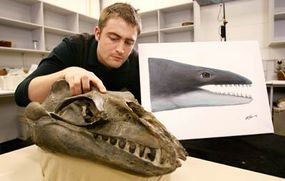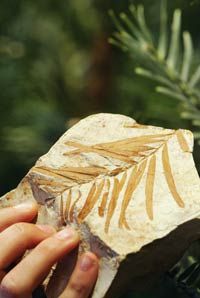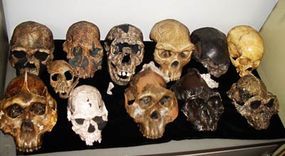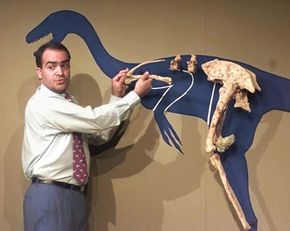Knowledge from Stone: Studying Fossils
The study of fossils is as much about relationships as it is about the study of specific plants and animals. When researchers look at a layer of rock, they look at all the fossils contained there, determining which species lived at the same time. By looking at neighboring rock layers, researchers can eventually determine how life has developed over the billions of years of the Earth's history. All these discoveries add up to create the fossil record -- the total collection of all the known fossils on Earth.
These relationships can give scientists a lot of clues about how life has changed over time. Here are some examples:
Advertisement
- A sudden increase in the number of fossilized algae can relate to a change in climate and available food sources.
- Fossilized pollen can reveal the types of trees and other plants that grew during specific periods, even if the plants themselves haven't been fossilized.
- Differences in the sizes of rings in petrified wood can correspond to changes in climate.

Other relationships can be more controversial. Scientists can use the relationships between fossils of different periods to support the theory of evolution. For example, a paleontologist might study the fossilized remains of prehistoric horses to determine how they relate to modern horses. The similarities between some dinosaur bones and the bones of today's birds suggest that some dinosaurs eventually evolved into birds.

Transitional fossils, or fossils that display the characteristics of more than one type of animal, can also support the theory of evolution. For example, the skull shown above is a 25-million-year-old fossil from a baleen whale. But unlike today's baleen whales, this one had sharp teeth. It appears to be an intermediate stage between extinct whales, which had legs and teeth, and today's whales.
Scientists can also use fossils to identify species of plants and animals that exist today. Researchers identified the species of pine tree shown at the right with the help of a 90-million-year-old fossil impression.
And fossils can even help researchers understand human life. Fossil specimens reveal many human-like ancestors that lived millions of years ago. The skulls pictured below are from a variety of ancient human ancestors, and they demonstrate how the shape of the skull, which relates to the size and structure of the brain, may have changed as humans developed.
These and other fossils have made massive contributions to life on Earth, and scientists continue to make new discoveries. Some of the newest finds come from newly-excavated fossil beds in China. One such bed is in Liaoning Province in northeast China. By 2005, researchers had excavated samples from 90 vertebrate species, 300 invertebrate species and 60 plant species. Some of these discoveries are filling holes in the fossil record, while others are supporting scientists' existing theories -- such as the idea that some dinosaurs had feathers.

On the next page, you'll find lots of links on fossils, dinosaurs, paleontology and related subjects.
Related HowStuffWorks Articles
More Great Links
Sources
- Edwards, Lucy E. and John Pojeta, Jr. "Fossils, Rocks and Time." USGS. (12/14/2007) http://pubs.usgs.gov/gip/fossils/contents.html
- Fields, Helen. "Dinosaur Shocker." Smithsonian Magazine. May 2006. (12/14/2007) http://www.smithsonianmag.com/science-nature/10021606.html
- Hecht, Jeff. "Tyrannosaurus Rex fossil gives up precious protein." New Scientist. 4/12/2007. (12/14/2007) http://www.smithsonianmag.com/science-nature/10021606.html
- Minnesota Department of Natural Resources. "Fossils - Clues to the Past." (12/14/2007) http://www.dnr.state.mn.us/education/geology/digging/fossils.html
- Palomar Community College. "Interpreting the Fossil Record." (12/14/2007) http://anthro.palomar.edu/time/time_1.htm
- Penney, David. "Fossils in Amber: Unlocking the Secrets of the Past." Biologist. Vol. 53, no. 5. October 2006.
- Protho, Donald R. "Fossils Say Yes." Natural History. Vol.114, issue 9. November 2005.
- Tarpy, Cliff. "Jewels in the Ash." National Geographic. Vol. 208 issue 2. August 2005.
- University of California Museum of Paleontology. "Fossil Record of Bacteria." (12/14/2007) http://www.ucmp.berkeley.edu/bacteria/bacteriafr.html
- University of California Museum of Paleontology. "Fossils: Windows to the Past." (12/14/2007) http://www.ucmp.berkeley.edu/paleo/fossils/
- University of California Museum of Paleontology. "Learning About the Vendian Animals." (12/14/2007) http://www.ucmp.berkeley.edu/vendian/critters.html
- University of California Museum of Paleontology. "Plant Fossils and their Preservation." (12/14/2007) http://www.ucmp.berkeley.edu/IB181/VPL/Pres/PresTitle.html
- University of Florida. "Fossil Preparation and Conservation." (12/14/2007) http://www.flmnh.ufl.edu/natsci/vertpaleo/resources/prep.htm
- University of Wisconsin-Madison. "Brief Guide to Preparing Fossils with Dental Picks." (12/14/2007) http://www.geology.wisc.edu/~museum/hughes/DentalPicks.html
